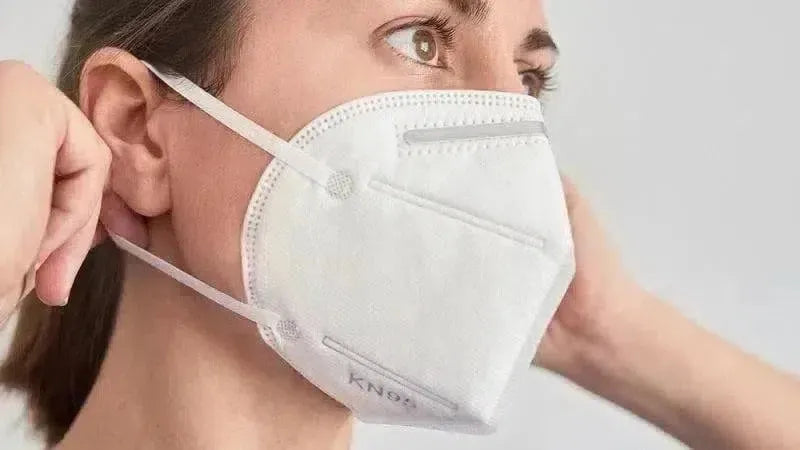KN95 Mask: 11 Things You Need to Know Before Buying

-
What Does KN95 Mean?
KN95 stands for the regulatory standard for filtering facepiece respirators that are certified in China. The regulatory standard refers to a design that ensures filtration efficiency, tight seal with the face as well as minimum leakage.
The certification is applied in terms of use against non-oily particulates, as well as the current use against the COVID-19.
It is important to mention that the requirements for a KN95 certification are almost the same as the requirements for the US N95 filtering facepiece respirators.
That is why both KN95 and N95 provide the same levels of protection, according to international standards and certifications.
-
What Is A KN95 Mask?
KN95 respiratory masks are masks that are regulated by the Chinese government under regulations GB2626-2006, GB262-2019, and GB19083-2010. These masks have become generally available to larger masses in April 2020, to help the Chinese people, as well as other countries, fight the COVID-19 pandemic.
The KN95 filtering facepiece respirators are also used by healthcare professionals, since the masks were approved by the FDA, according to the FDA guidelines and international standards.
When it comes to the KN95 mask itself, it is designed to fit tightly around the face, due to its ability to create an airtight seal. This mask features an ear loop as a form of wearing, which is different from other types of masks that use head strap attachments that either go behind the ears or behind the neck.
When it comes to public opinion, many seem to favor the KN95 mask design, as the mask can be put on fast and easy, and it also fits very well from the nose to the chin area (to prevent particles from entering nose and mouth).
-
What Does A KN95 Mask Protect You From?
The KN95 mask is supposed to provide effective respiratory protection against all sorts of particles, including bacteria and viruses.
The KN95 masks are also supposed to provide 95% protection against all particles that are greater than 0.3 µm in diameter.
This means that the mask is supposed to protect you from bacteria, viruses, pollution particles, fine particles, dust, smog, pollen, and reduce the risk of bacterial and viral infections.
-
What Are KN95 Masks Made From?
The KN95 masks are multi-layer masks, that usually feature 5-layer protection. The layers are made from high-quality, nonwoven fabric, hot air cotton, and melt-blown fabric.
The nonwoven fabric is hydrophobic and is water- and droplet-proof. Moreover, the hot air cotton is soft and ensures lower air velocity. Further layers ensure particle filtration and hypoallergenic materials, that are skin-friendly.
Such a layered fabric construction contributes to the mask’s particle filtering efficiency and a generally better design. Speaking of design, the KN95 mask has a 3D foldable design, as well as an adjustable nose bridge clip to fit the face better and firmer.
Unlike other masks, the KN95 mask features an elastic ear loop as well, which further ensures tight and firm fitting to the face, from nose to chin area.
Note: Some KN95 masks have 4 instead of 5 layers. However, these 4-layered masks are generally cheaper, and not recommended for use against COVID-19. The WHO and CDC recommend respiratory masks with 5 layers only.
-
How Long Can You Use A KN95 Mask?
Both the US N95 and Chinese KN95 masks are manufactured and designed for one-time use (disposable design).
This means that each new use would require a new mask. However, because of the shortage of the N95 and KN95 masks, the CDC has recommended reusing of the disposable filtering facepiece respirators as a crisis capacity strategy.
The strategies for the extended use of masks like N95 or KN95 are available at The National Institute for Occupational Safety and Health (NIOSH).
According to NIOSH, masks like N95 and KN95 can be reused (only if properly stored between uses and only if used by one and same individual), and used for an extended period of time (meaning that an individual wears the same mask for a continuous period of time in one day, after which the mask should be disposed of due to repeated exposure and close contact).
-
Is KN95 Mask Efficient?
KN95 masks are created to have at least 95% filtration efficiency, which makes them just as good as the N95 masks (97% filtration efficiency) and better than surgical masks (95% filtration efficiency) and PM 2.5 filter masks (approximately 60% filtration efficiency).
Generally, these masks are considered highly effective against airborne particles, viruses, and bacteria, as their efficiency was tested and proven through international regulations and regulatory standards of FDA, CDC, etc.
However, studies have shown that the filtration efficiency of KN95 masks, for example, drops after sterilization or extended use. The filtration efficiency can drop even 50% post-sterilization.
The reason for that lies in the fact that filtering facepiece respirators are made to be used one time and then be disposed of.
That is why caution should be exercised when reusing or sterilizing respiratory masks.
Moreover, further studies are expected to be conducted when it comes to overall filtration efficiency against infectious agents and filtration limitations of masks like N95 or KN95.
That is why the CDC only recommends extended use if the mask maintains its fit and function and is safely stored between the use (if it’s being reused).
-
Does WHO Recommend KN95 Masks Against COVID-19?
The WHO has provided guidance and available evidence when it comes to the use of respiratory masks like KN95 as a protective measure against COVID-19.
So far, what they know is that these masks should be effective against virus transmission and for protection against infection.
These masks are being used by health care providers and because it is believed that they protect from at least 95% of all particles, bacteria, and viruses, their use will be continued.
However, the WHO states and emphasizes that there are currently NOT ENOUGH studies to evaluate the effectiveness of respiratory masks like N95 or KN95 against Coronavirus in particular. However, they do advise these masks should be worn as a part of the protective measure strategy regarding infection transmission and the prevention of virus transmission among health care providers, patients, and citizens.
-
How To Handle KN95 Masks?
According to the Crisis Standards of Care by CDC, decontamination recommendations in regards to handling a decontaminated mask are as follows;
- Before and after touching or adjusting of the respiratory mask, you should clean your hands with soap and water, o ran alcohol-based sanitizer with at least 60% alcohol.
- Avoid touching the inside of the mask.
- When touching and adjusting the mask, make sure to use a pair of clean (non-sterile) gloves.
- Always visually inspect the respiratory mask to see whether its composition and fitting have been compromised.
- Always make sure to check whether the mask components like nose bridge, straps, and nose foam material did not degrade (which can compromise the mask efficiency, quality of the fit, and seal).
- Always make sure to discard a used respiratory mask properly and never leave it exposed, where other people can touch it or use it.
-
How To Spot A Counterfeit KN95 Mask?
Not all KN95 masks and brands available on the market are authentic, and due to the shortage of the masks, there are many counterfeit KN95 mask brands. Some of the signs that a respiratory mask is counterfeit are the following;
- There are no markings on the filtering facepiece respirator mask whatsoever,
- There are no NIOSH-approved filtering facepiece respirator designations (like N95, N99, N100, R95, R99, R100, P95, P99, P100).
- NIOSH is spelled incorrectly on the box or packaging,
- There is an FDA logo on the box or packaging of the mask; FDA does NOT approve the use of the administration label on any respirator packaging,
- Presence of decorative fabric or other decorative add-ons (e.g. sequins),
- There are claims that the mask is approved for children (NIOSH does NOT approve any of the respiratory protection for children)There are straps for ears instead of ear loops for KN95 maskHere are some further tips on how you can test KN95 mask to see if it’s fake;
- Flammability– if a mask is KN95 certified, when exposed to a flame it should melt but not ignite. Counterfeit KN95 masks are made from cheap materials and will ignite when in contact with a flame.
- Permeability– if a mask is KN95 certified, it should limit the airflow going in and out of the mask. You can test this by trying to blow out a candle or a flame of a lighter by blowing through the mask. With a KN95 rated mask, you shouldn’t be able to blow out the flame no matter how hard you blow.
- Liquid Resistance – if a mask is KN95 certified, it will have a waterproof layer that will prevent the passage of fluid. You can test this by pouring some water into the mask. A certified KN95 mask will contain all the water with no leakage, while a counterfeit mask will allow the water to flow through the mask.
- Should I Buy A KN95 Mask with A Valve?
According to the latest CDC updates, you should stay away from KN95 masks that feature an exhalation valve. The reason for this lies in the fact that one-way valve masks allow air to be exhaled through a hole in the mask material.
This results in exhaled respiratory droplets possibly reaching others. In cases of infected people wearing such masks, there can be a potential danger for people in their immediate environment, especially those not wearing a mask themselves. The CDC recommends we wear simple facial masks that don’t feature a valve or vent.
-
How Do I Get A Proper Fit with A KN95 Mask?
To put the KN95 mask properly, make sure to do as follows.
- You should wash your hands thoroughly with soap and water or alcohol-based sanitizer before putting the mask.
- Hold the ear loop mask and nosepiece facing up and place the mask under your chin.
- Stretch the ear loops over each ear.
- Position and adjust the mask on your nose by using both of your hands. You should mold the nosepiece to the shape of your nose and push downwards on both sides of the nosepiece.
- Always perform a fit and seal check by placing both hands over the mask. Make sure not to move or disturb the position of the mask. You can test whether the mask fits properly by exhaling; if there is air leakage, then make sure to adjust the mask again, especially the nosepiece.










